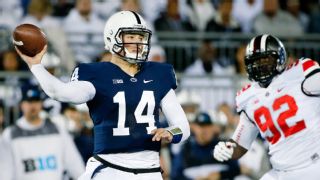|
Let’s get the obvious out of the way: Historically, the Big Ten hasn’t been a great passing conference. How bad has it been? Well, when it comes to producing 2,500-yard passers, we crunched the numbers and found that no Power 5 conference has had fewer -- either in 2014 or over the past five seasons -- than the ground-and-pound conference. Over the past five years, there has been a wide gulf between the B1G and everybody else. Even when you take all the B1G realignment into account, a B1G team produces a 2,500-yard quarterback at less than a 40 percent clip. Compare that to the Pac-12 (68.3 percent) or even the SEC (48.6 percent), and it’s not too pretty.  But it’s not all doom-and-gloom for the Big Ten. This season should put an end -- at least temporarily -- to those poor passing numbers. Three returning Big Ten signal-callers reached the milestone last season and are near-locks to surpass 2,500 yards again: Michigan State’s Connor Cook, Penn State’s Christian Hackenberg, and Nebraska’s Tommy Armstrong. But it’s not all doom-and-gloom for the Big Ten. This season should put an end -- at least temporarily -- to those poor passing numbers. Three returning Big Ten signal-callers reached the milestone last season and are near-locks to surpass 2,500 yards again: Michigan State’s Connor Cook, Penn State’s Christian Hackenberg, and Nebraska’s Tommy Armstrong.
Ohio State’s J.T. Barrett also surpassed 2,500 yards in 2014, although there is no telling what his numbers might be with a crowded race under center. Still, boasting three NFL-caliber quarterbacks on the same roster should merit some extra credit. On top of those four returners, healthy quarterbacks like Nate Sudfeld and Wes Lunt have great opportunities for 2,500 yards, and Iowa was just 64 yards shy last season after C.J. Beathard split time with Jake Rudock. With Rudock seeking a transfer, that passing mark seems more attainable this season. Maryland also would have achieved the feat last season if C.J. Brown had remained healthy, so Caleb Rowe could very well end the Terps’ seven-year drought this season. Other teams need to settle on their quarterbacks first. And no one is expecting Wisconsin or Minnesota to become pass-first teams overnight. But trends like this tend to happen in cycles, and it looks as if the Big Ten is finally on an upswing in 2015. It’s basically the opposite message from last week, with the 1,000-yard rushing club. The Big Ten had a great 2014, and it likely won’t equal that rushing performance again in 2015. With passing, it saw only five of 14 starting quarterbacks surpass 2,500 yards last season -- again, the worst among the Power 5, by far -- but it would be a huge surprise if it didn’t improve upon that number. Now, our most recent chart doesn’t necessarily measure passing success. Two- and three-quarterback systems, signal-caller battles and injured players tend to blur those numbers, but this should be a memorable year for the B1G through the air. If Purdue, Michigan, Northwestern or Rutgers can settle on a starter and get off to a quick start, it could be even better.
|
